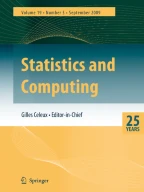Abstract
We propose an adaptive procedure for improving the response outcomes of complex combinatorial experiments. New experiment batches are chosen by minimizing the co-information composite likelihood (COIL) objective function, which is derived by coupling importance sampling and composite likelihood principles. We show convergence of the best experiment within each batch to the globally optimal experiment in finite time, and carry out simulations to assess the convergence behavior as the design space size increases. The procedure is tested as a new enzyme engineering protocol in an experiment with a design space size of order 107.



Similar content being viewed by others
Explore related subjects
Discover the latest articles, news and stories from top researchers in related subjects.References
Addelman, S.: Sequences of two-level fractional factorial plans. Technometrics 11, 477–509 (1969)
Allen, T.T., Rajagopalan, R.: A Bayesian plotting method for fractional factorial data analysis. J. Qual. Technol. 43, 224–235 (2011)
Bell, A.J.: The co-information lattice. In: Proceedings of the Fifth International Workshop on Independent Component Analysis and Blind Signal Separation: ICA 2003 (2003)
Box, G.E.P., Meyer, R.D.: An analysis for unreplicated fractional factorials. Technometrics 28, 11–18 (1986)
Box, G.E.P., Meyer, R.D.: Finding the active factors in fractionated screening experiments. J. Qual. Technol. 25, 94–105 (1993)
Box, G.E.P., Wilson, K.B.: On the experimental attainment of optimum conditions. J. R. Stat. Soc. B 13, 1–45 (1951)
Chaloner, K., Verdinelli, I.: Bayesian experimental design: a review. Stat. Sci. 10, 273–304 (1995)
Conti, S., O’Hagan, A.: Bayesian emulation of complex multi-output and dynamic computer models. J. Stat. Plan. Inference 140(3), 640–651 (2010)
Conti, S., Gosling, J.P., Oakley, J.E., O’Hagan, A.: Gaussian process emulation of dynamic computer codes. Biometrika 96(3), 663–676 (2009)
Daniel, C.: Sequences of fractional replicates in the 2p−q series (Corr: V57 p919). J. Am. Stat. Assoc. 57, 403–429 (1962)
Daniel, C.: Applications of Statistics to Industrial Experimentation. Wiley-Interscience, New York (1976)
Dean, A.M., Lewis, S.M. (eds.): Screening: Methods for Industrial Experimentation, Drug Discovery and Genetics. Springer, New York (2006)
Gilmour, S.G., Mead, R.: Stopping rules for sequences of factorial designs. Appl. Stat. 44, 343–355 (1995)
Gilmour, S.G., Mead, R.: Fixing a factor in the sequential design of two-level fractional factorial experiments. J. Appl. Stat. 23, 21–29 (1996)
Gilmour, S.G., Mead, R.: A Bayesian design criterion for locating the optimum point on a response surface. Stat. Probab. Lett. 64(3), 235–242 (2003)
John, P.W.M.: Augmenting 2n−1 designs. Technometrics 8, 469–480 (1966)
Kirkwood, J.G., Boggs, E.M.: The radial distribution function in liquids. J. Chem. Phys. 10, 394–402 (1942)
Kroese, D.P., Porotsky, S., Rubinstein, R.Y.: The cross-entropy method for continuous multi-extremal optimization. Methodol. Comput. Appl. Probab. 8(3), 383–407 (2006)
Lieber, D., Rubinstein, R.Y., Elmakis, D.: Quick estimation of rare events in stochastic networks. IEEE Trans. Reliab. 46(3), 254–265 (1997)
Lindsay, B.G.: Composite likelihood methods. In: Prabhu, N.U. (ed.) Statistical Inference from Stochastic Processes, pp. 221–239. American Mathematical Society, Providence (1988)
Longhi, S., Czjzek, M., Lamzin, V., Cambillau, C.: Atomic resolution 1.0a crystal structure of fusarium solani cutinase: stereochemical analysis. J. Mol. Biol. 268, 779–799 (1997)
Matsuda, H.: Physical nature of higher-order mutual information: intrinsic correlations and frustration. Phys. Rev. E 62(3), 3096–3102 (2000)
McGill, W.J.: Multivariate information transmission. Psychometrika 19, 97–116 (1954)
Minervini, G., Evangelista, G., Villanova, L., Slanzi, D., De Lucrezia, D., Poli, I., Luisi, P.L., Polticelli, F.: Massive non-natural proteins structure prediction using grid technologies. BMC Bioinform. 10, 1–9 (2009)
Myers, R.H., Montgomery, D.C.: Response Surface Methodology: Process and Product Optimization Using Designed Experiments. Wiley, New York (2009)
Pajak, T., Addelman, S.: Minimum full sequences of 2n−m resolution III plans. J. R. Stat. Soc. B 37, 88–95 (1975)
Pearl, J.: Probabilistic Reasoning in Intelligent Systems: Networks of Plausible Inference. Morgan Kaufmann, San Mateo (1997)
Rubinstein, R.Y., Kroese, D.P.: The Cross-Entropy Method: A Unified Approach to Monte Carlo Simulation, Randomized Optimization and Machine Learning. Springer, Berlin (2004)
Santner, T.J., Williams, B., Notz, W.: The Design and Analysis of Computer Experiments. Springer, Berlin (2003)
Singer, A.: Maximum entropy formulation of the Kirkwood superposition approximation. J. Chem. Phys. 121(8), 3657–3666 (2004)
Watanabe, S.: Information theoretical analysis of multivariate correlation. IBM J. Res. Dev. 4, 66–82 (1960)
Wu, C., Hamada, M.: Experiments: Planning, Analysis, and Parameter Design Optimization. Wiley, New York (2000)
Zlochin, M., Birattari, M., Meuleau, N., Dorigo, M.: Model-based search for combinatorial optimization: a critical survey. Ann. Oper. Res. 131(1–4), 373–395 (2004)
Author information
Authors and Affiliations
Corresponding author
Appendix: Proofs
Appendix: Proofs
1.1 A.1 Proof of Proposition 1
The parameter estimate computed at step t+1 solves the following set of equations over Θ KSA :

As n→∞, by Assumptions A1–A3, the right hand side of the above equation converges to a quantity proportional to

Note that
where ρ t =ℙ(Y t ≥γ t ). By Assumption A4, there exist θ t+1∈Θ KSA such that setting θ=θ t+1 in (6.2) gives

As n→∞, for the solution of (6.2) evaluated at the optimal point x ∗, we have

1.2 A.2 Proof of Proposition 2
Let β t =c ϵ /ρ t . Proposition 1 implies
where p 0=p 0(x ∗). When n is large, Proposition 1 implies

Taking the log in the right hand side of the above expression gives

as T→∞ if . This proves (3.1). Moreover, (6.3) and (6.4) imply the bound in (3.2).
Rights and permissions
About this article
Cite this article
Ferrari, D., Borrotti, M. & De March, D. Response improvement in complex experiments by co-information composite likelihood optimization. Stat Comput 24, 351–363 (2014). https://doi.org/10.1007/s11222-013-9374-8
Received:
Accepted:
Published:
Issue Date:
DOI: https://doi.org/10.1007/s11222-013-9374-8


